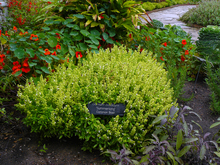My first gardening book was Rodale’s Illustrated Encyclopedia of Herbs. With its broken spine and pages falling out, it is a well-used, well-loved tome of everything about herbs. I was hooked from the start. And to this day, my garden and containers are always filled with herbs.
The International Herb Association established National Herb Week the week before Mother’s Day. This year, it is May 3-7.
A great resource for herb growers, the Herb Society of America defines herbs as “plants (trees, shrubs, vines, perennials, biennials, or annuals) valued historically, presently, or potentially” for their use to humans.
Minnesota has its own herb society too. It’s active members plan and plant the herb garden at the MN Landscape Arboretum each year.
Easy to grow
Herb gardening is one of the easiest and oldest types of gardening. Before modern medicine, herbs were used for medicinal purposes and still are today.
As garden plants, herbs are kind and forgiving and grow well under conditions that other plants would find difficult. Dry soil, poor soil, full sun - herbs do well in all of these conditions.
They are great plants for containers and gardens alike — whether you have a few pots on an apartment balcony, some planters on a patio, or a full-blown garden bed. Herbs are easy plants to love.
Visit Vegetables A-Z to learn more on how to grow various herbs.
Herbs as food
Herbs feed us too. Who doesn’t love fresh basil with tomatoes and cheese? Or garden sage (my personal favorite) in wild rice? How about lavender or mint-flavored sugar in your tea or cilantro on your arrachera? Herbs can be used to flavor vinegar and oil, for hot and cold teas, as dyes and personal products, and featured in arts and crafts.
Herbs also feed pollinators, birds and animals. Let some of your herbs flower to provide nectar for the all-important native and honey bees. Butterflies flit from flower to flower, drinking nectar. Syrphid flies hover over edible flowers like bachelor buttons, alighting to forage. Hummingbirds drink nectar and birds feed on seed heads.
Celebrate all the wonders of herbs this National Herb Week by including them in the plant list for your garden, whether big or small or somewhere in between!


